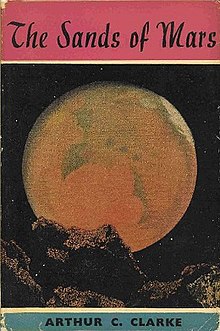
Interplanetary spaceflight or interplanetary travel is the crewed or uncrewed travel between stars and planets, usually within a single planetary system. In practice, spaceflights of this type are confined to travel between the planets of the Solar System. Uncrewed space probes have flown to all the observed planets in the Solar System as well as to dwarf planets Pluto and Ceres, and several asteroids. Orbiters and landers return more information than fly-by missions. Crewed flights have landed on the Moon and have been planned, from time to time, for Mars, Venus and Mercury. While many scientists appreciate the knowledge value that uncrewed flights provide, the value of crewed missions is more controversial. Science fiction writers propose a number of benefits, including the mining of asteroids, access to solar power, and room for colonization in the event of an Earth catastrophe.

Mars, the fourth planet from the Sun, has appeared as a setting in works of fiction since at least the mid-1600s. Trends in the planet's portrayal have largely been influenced by advances in planetary science. It became the most popular celestial object in fiction in the late 1800s, when it became clear that there was no life on the Moon. The predominant genre depicting Mars at the time was utopian fiction. Around the same time, the mistaken belief that there are canals on Mars emerged and made its way into fiction, popularized by Percival Lowell's speculations of an ancient civilization having constructed them. The War of the Worlds, H. G. Wells's novel about an alien invasion of Earth by sinister Martians, was published in 1897 and went on to have a major influence on the science fiction genre.

Space exploration is the use of astronomy and space technology to explore outer space. While the exploration of space is currently carried out mainly by astronomers with telescopes, its physical exploration is conducted both by uncrewed robotic space probes and human spaceflight. Space exploration, like its classical form astronomy, is one of the main sources for space science.
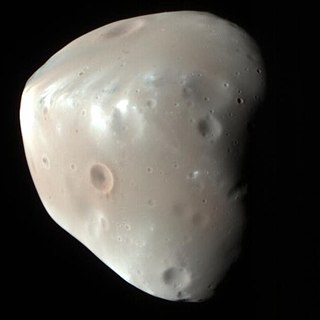
Deimos is the smaller and outer of the two natural satellites of Mars, the other being Phobos. Deimos has a mean radius of 6.2 km (3.9 mi) and takes 30.3 hours to orbit Mars. Deimos is 23,460 km (14,580 mi) from Mars, much farther than Mars's other moon, Phobos. It is named after Deimos, the Ancient Greek god and personification of dread and terror.

Alien invasion or space invasion is a common feature in science fiction stories and film, in which extraterrestrial lifeforms invade the Earth to exterminate and supplant human life, enslave it, harvest people for food, steal the planet's resources, or destroy the planet altogether. It can be considered as a science-fiction subgenre of the invasion literature, expanded by H. G. Wells's seminal alien invasion novel The War of the Worlds, and is a type of "first contact" science fiction.
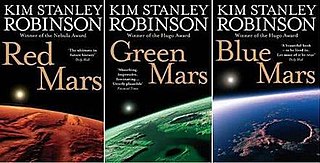
The Mars trilogy is a series of science fiction novels by Kim Stanley Robinson that chronicles the settlement and terraforming of the planet Mars through the personal and detailed viewpoints of a wide variety of characters spanning almost two centuries. Ultimately more utopian than dystopian, the story focuses on egalitarian, sociological, and scientific advances made on Mars, while Earth suffers from overpopulation and ecological disaster.
A sleeper ship is a hypothetical type of crewed spacecraft, or starship in which most or all of the crew spend the journey in some form of hibernation or suspended animation. The only known technology that allows long-term suspended animation of humans is the freezing of early-stage human embryos through embryo cryopreservation, which is behind the concept of embryo space colonization.

Earthlight is a science fiction novel by British writer Arthur C. Clarke, published in 1955. It is an expansion to novel length of a novella of the same name that he had published four years earlier.
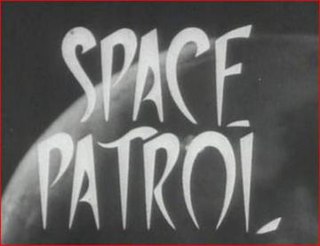
Space Patrol is a British science-fiction television series featuring marionettes that was produced in 1962 and broadcast from the beginning of April 1963. It was written and produced by Roberta Leigh in association with ABC Weekend TV.
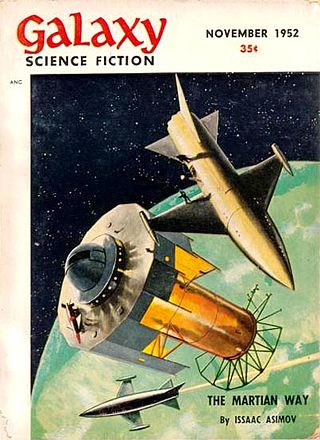
The Martian Way is a science fiction novella by American writer Isaac Asimov. It was first published in the November 1952 issue of Galaxy Science Fiction and reprinted in the collections The Martian Way and Other Stories (1955), The Best of Isaac Asimov (1973), and Robot Dreams (1986). It was also included in The Science Fiction Hall of Fame, Volume Two (1973) after being voted one of the best novellas up to 1965.

David Starr, Space Ranger is the first novel in the Lucky Starr series, six juvenile science fiction novels by Isaac Asimov that originally appeared under the pseudonym Paul French. The novel was written between 10 June and 29 July 1951 and first published by Doubleday & Company in January 1952. Since 1971, reprints have included an introduction by Asimov explaining that advancing knowledge of conditions on Mars have rendered some of the novel's descriptions of that world inaccurate. The novel was originally intended to serve as the basis for a television series, a science-fictionalized version of The Lone Ranger, but the series was never made, in part because another series called Rocky Jones, Space Ranger was already in the planning stages.

Colonization or settlement of Mars is the theoretical migration of humans to Mars and the establishment of long-term human presence on the planet. The prospect has garnered interest from public space agencies and private corporations and has been extensively explored in science fiction writing, film, and art. Organizations have proposed plans for a human mission to Mars, the first step towards any colonization effort, but thus far no person has set foot on the planet, and there have been no return missions. However, landers and rovers have successfully explored the planetary surface and delivered information about conditions on the ground.

Islands in the Sky is a 1952 science fiction novel by British writer Arthur C. Clarke. It is one of his earliest works. Clarke wrote the story as a travelogue of human settlement of cislunar space in the last half of the twenty-first century.

"The Red Peri" is a science fiction novella by American writer Stanley G. Weinbaum, which first appeared in the November 1935 issue of Astounding Stories. Sam Moskowitz has noted that Weinbaum planned to write a series of sequels to "The Red Peri" but died before he could do so. "The Red Peri" is the only Weinbaum story set on Pluto. The novel also inspired Arthur C. Clarke, who stated that David Bowman's helmetless spacewalk in 2001: A Space Odyssey was inspired by Frank Keene's escape from the pirate base in "The Red Peri".

The idea of sending humans to Mars has been the subject of aerospace engineering and scientific studies since the late 1940s as part of the broader exploration of Mars. Long-term proposals have included sending settlers and terraforming the planet. Currently, only robotic landers and rovers have been on Mars. The farthest humans have been beyond Earth is the Moon, under the NASA's Apollo program.
The following is a list of works by Arthur C. Clarke.

The Mars Project is a 1952 non-fiction scientific book by the German rocket physicist, astronautics engineer and space architect Wernher von Braun. It was translated from the original German by Henry J. White and first published in English by the University of Illinois Press in 1953.
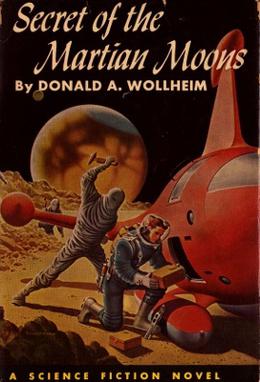
The Secret of the Martian Moons is a science-fiction novel by Donald A. Wollheim. It was first published in 1955 by the John C. Winston Company. Playing world-class hide-and-seek with the Martians, Nelson Parr believes that he has found them... until the real Martians show up. This is the second novel that Wollheim wrote for Winston, the other two being The Secret of Saturn's Rings (1954) and The Secret of the Ninth Planet (1959).
The following outline is provided as an overview of and topical guide to Mars:

Project Mars: A Technical Tale is a science fiction novel by German-American rocket physicist, Wernher von Braun (1912–1977). It was written by von Braun in German in 1949 and entitled Marsprojekt. Henry J. White (1892–1962) translated the book into English and it was published later by Apogee Books (Canada) in 2006 as Project Mars: A Technical Tale, almost thirty years after von Braun's death. The original German text remains unpublished.
